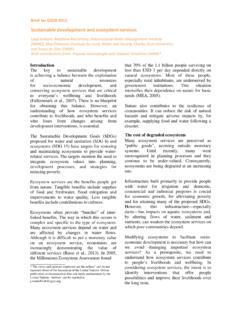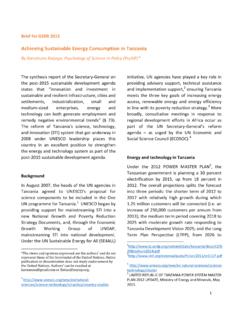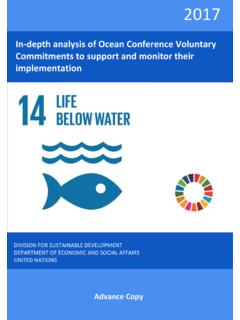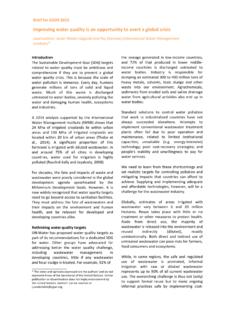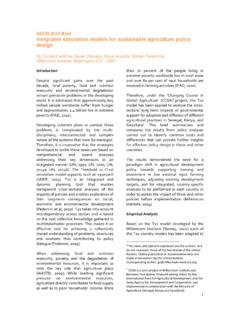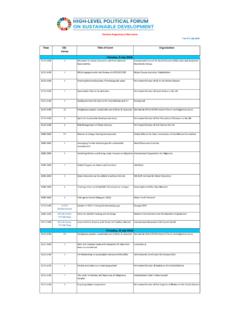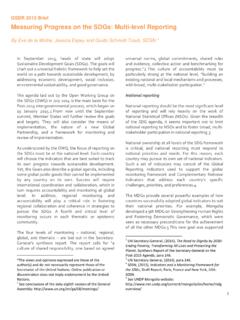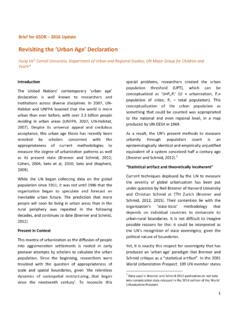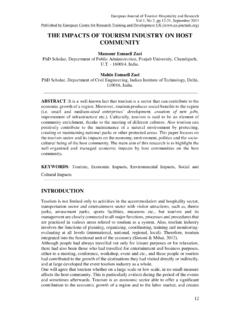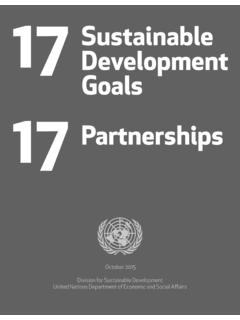Transcription of Compendium of Best Practices in Sustainable Tourism
1 Compendium of best Practices in Sustainable Tourism Fen Wei Prepared for United Nations Department of economic and Social Affairs Intro The United Nations Conference on Sustainable Development (Rio+20), held in June 2012, emphasized in its outcome document The Future We Want 130-131, that Sustainable Tourism , well managed and designed, can make significant contributions to Sustainable development . Rio+20 further encouraged investments in Sustainable Tourism , including in ecotourism and cultural Tourism , small business creation and called for facilitating access to finance, including through micro credits issued to local communities, the poor, and to indigenous peoples. Against this background, the United Nations Department of economic and Social Affairs (DESA) and its Division for Sustainable Development (DSD) has conducted, in partnership with UNEP, UNWTO and UNESCO, an Expert Group Meeting on Sustainable Tourism : Ecotourism, Poverty Reduction and Environmental Protection, held in New York, October 2013.
2 To further facilitate the dialogue, DESA commissioned the Compendium of best Practices for promotion of Sustainable (eco) Tourism . This Compendium , as a supplementary document to the EGM, consists of 18 best Practices in Sustainable (eco) Tourism initiated by governments, NGOs, and private sectors, in developing countries, including SIDS, with potentials for replication elsewhere. The best Practices were collected and analyzed by four main criteria: Conservation, Community, Culture, and Commerce, initiated by The Zeitz Foundation, the main pillars of Sustainable (eco) Tourism . Disclaimer The views and opinions expressed do not necessarily represent those of the Secretariat of the United Nations; the designations employed or terminology used concerning the legal status of any country, territory, city or area of its authorities, or concerning the delimitation of frontiers do not imply the expression of any opinion whatsoever on the part of the Secretariat of the United Nations.
3 The designations of country groups in the text, figures or tables are intended solely for analytical convenience and do not necessarily express a judgment about the stage reached by a particular country or area in the development process. Mention of names of firms and commercial products does not imply endorsement of the United Nations. This document has been issued without formal editing. -1- Table of Contents Intro .. 1. best Practice Cases .. 3. i. Zeitz Foundation, Kenya .. 3. ii. Air New Zealand .. 5. iii. Andaman Discoveries, Thailand .. 7. iv. Caribbean Tourism Organization .. 9. v. Crosswater Lodge. China .. 11. vi. Experiencias Xcaret, Mexico .. 13. vii. Feynan Ecolodge, Jordan .. 15. viii. Fr gate Island Private Seychelles .. 17. ix. Hidden Valley Inn Reserve, Belize .. 19. x. Matin Abad Desert Camp & Organic Farm, Iran .. 21. xi. Mt. Huangshan Scenic Area Administrative Committee, 23. xii. Premiki, Slovenia .. 25. xiii. Rivers Fiji .. 27. xiv. Shamwari Game Reserve, Eastern Cape.
4 29. xv. The Blue Yonder, India .. 31. xvi. The Bushcamp Company, Zambia .. 33. xvii. The Tryall Club, Jamaica .. 35. xviii. Wilderness Foundation, Eastern Cape .. 37. ! ! -2- Zeitz Foundation A non-profit organization that promotes responsible Tourism in southern Africa and beyond Key Words 4Cs Zeitz Foundation was founded in 2008 by the business entrepreneur Jochen Zeitz with the mission to create and support Sustainable , ecologically and socially responsible projects and destinations around the world to achieve long-lasting impact and sustainability through the holistic balance of Conservation, Community, Culture and Commerce (the 4Cs) in privately managed areas. The Zeitz Foundation delivers on its vision and mission through two inter-linked programmes, the global Long Run Initiative and the Laikipia Programme in Kenya. The Long Run Initiative (LRI) pursues the Zeitz Foundation's mission internationally. By enhancing ecosystems management and building recognition and support for the 4Cs approach to sustainability, the LRI is creating a driving force to promote and encourage Sustainable thinking globally.
5 LRI aims to reach out into every aspect of daily life by putting into practice the Long Run philosophy of acting today for a better tomorrow. The Laikipia Programme, centred in the Greater Segera area of Laikipia County, Kenya, is the nursery' in which innovative initiatives that encompass and represent the 4Cs approach to sustainability are nurtured and parented. When they approach maturity and show real signs of promise, the lessons and experiences are shared throughout the LRI network. The Long Run Initiative (LRI): The LRI is built around Global Ecosphere Retreats (GER) certified Long Run Destinations, Long Run Alliance Members and Long Run Supporters. Long Run Supporters are organizations from a variety of different sectors that believe in and support the LRI mission, while Long Run Alliance Members are primarily Tourism - focused enterprises that directly manage or significantly influence the management of a natural area of conservation value with defined geographical boundaries that are committed to achieving sustainability through a holistic balance of the 4Cs.
6 Long Run Alliance Members are required to meet stringent criteria in accordance with the 4Cs and that have committed to continuous improvements to eventually become certified Long Run Destinations, which are global leaders in Sustainable Tourism . In order to become a GER certified Long Run Destination, rigorous criteria must be met through a detailed strategic plan (E4C plan) that confirms actions and results in respect to the 4Cs and ensures that best Practices are adhered to and innovative approaches experimented with to develop more Sustainable solutions. Over the past four years the Long Run Initiative has experienced fast growth. Today -3- it includes 8 GER certified Long Run Destinations, 28 Long Run Alliance Members and 38 Long Run Supports spanning six continents. The Long Run Alliance Members and GER certified Long Run Destinations together manage or significantly influence the management of million acres and protect numerous rare or endangered species.
7 Examples of GER certified LRD member activities include: a comprehensive programme to combat malaria by Nihiwatu (LRD) in Indonesia, which covers a 120. square kilometre area encompassing 400 villages and 22,000 people; jaguar conservation in Caiman Ecological Refuge (LRD) in Brazil in an area covering 130,966 acres; promotion of the concept of financially viable conservation to local landowners at Wolwedans (LRD) in Namibia to further expand the existing 444,789. acre Namib Rand Nature Reserve; and the support of indigenous community Tourism as a viable business model to protect the Huaorani's thousand-year-old culture at Huaorani Ecolodge (LRAM) in Ecuador. The Zeitz Foundation directly supports innovative projects in LRDs. Examples include: an artificial wetland project at Monte Azul (LRD) in Costa Rica, which involves close to 2,000 people through teaching and capacity building; a project by Tahi (LRD) on the restoration of the biodiversity of Pataua North in New Zealand where alien invasive plant species are eradicated and the biodiversity of the forest, beach, wetland and estuarine habitat are restored ina 2,000 acre area.
8 Sources: The Zeitz Foundation Global Ecosphere Retreats (GER) Certification Photograph courtesy The Zeitz Foundation official website -4- Air New Zealand Air New Zealand Environment Trust Key Words Conservation; Community Air New Zealand has achieved great accomplishments in its efforts to become the lead in environmental sustainability of airline industry and its commitment to help the country in maintaining its international clean and green image. Its commitment effectively reduced the carbon emissions by 15%, initiated using of biofuel for transportation on ground and investment in new models of fuel-efficient aircrafts. To support New Zealand with its conservation projects of biodiversity, the airline also established the Air New Zealand Environment Trust (ANZET) to support biodiversity conservation projects in New Zealand, in partnership with other organizations and companies, encouraging donations from other potential resources and customers. For community and culture, Air New Zealand sponsors projects of environmental education to help kids understand the importance and to protect the cultural heritage of Maori.
9 Conservation ANZET's initial programs of conservation: widespread native reforestation and more than 100 acres of tree planting in Hawke's Bay area on Mangarara Station. 60,000 trees will be planted over marginal land in three years starting from 2008, with the Trust. Trees for shelter are being planted for stock, and a sanctuary of 30-hectare lake restored for ducks, swans and weweia. ANZET will sponsor the island nursery through a two-year funding for the Motutapu Restoration Trust to help with its upgrade and expansion. Forest footprint will double annually on the island, which will help speed up the revegetation of the island by 100%. Local cultural landscape will be protected and maintained for Maori. Natural heritage will be recovered for the island, and the biggest haven for the island wildlife will be built in the country. ANZET's funding for Glaciers to Wetlands Restoration Project will be implemented through Department of Conservation (DOC) for a period of four year.
10 At Okarito, DOC built a local nursery to help the affected areas in the wetland system increase native plants. Thousands of seeds and seedlings will be distributed in 4 years. At the Lake Wahapo kahikatea swamp forest, new vegetation is protected with a fence. Around the Okarito Lagoon, a trapping network is built to bring down the -5- numbers of mammalian predators in order to protect native bird species. ANZET is helping revegetate Pilot's Beach to preserve and develop it as A Little Blue Penguin nesting habitat for the growing visitors there. The Te Awa River Ride Project is initiated for a 70km shared cycle / walkway access along the Waikato River. Soil management is now handled in an integrated approach. Community Kids Restore New Zealand Programme from 2009. Grants are provided for environmental projects by kids on: Pest reduction and species diversity restoration, replanting a waste area, developing a wetland park, cleaning up and regenerating a local stream, planting a forest of native trees for the future or developing an area to be free of predators, etc.
